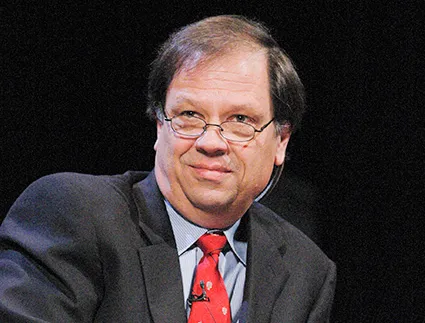
Photo by L.A. Cicero: William Newsome, a professor of neurobiology at Stanford School of Medicine, is one of the co-leaders of the BRAIN working group.
Stanford Report- April 2, 2013 - by Bjorn Carey
President Barack Obama announced today a bold research initiative aimed at developing new technologies and methods for understanding the human brain. Several Stanford scientists will play critical roles in the Brain Research through Advancing Innovative Neurotechnologies (BRAIN) project, which calls for initial funding of $100 million.
"As humans we can identify galaxies light-years away," President Obama said at a White House ceremony. "We can study particles smaller than an atom, but we still haven't unlocked the mystery of the three pounds of matter that sits between our ears."
The challenge of filling this knowledge gap is significant: The BRAIN initiative has the incredibly ambitious task of mapping the brain's roughly 100 billion neurons and the trillions of connections between them and then determining how signals pass between these neural circuits and how that process is controlled.
The process could create jobs – Obama noted that every dollar invested in the Human Genome Project returned $140 – and could eventually lead to treatments for Parkinson's and Alzheimer's diseases, autism, the deleterious effects of strokes and many other neurological conditions.
"There was a lot of excitement at the White House this morning," said William Newsome, a professor of neurobiology at Stanford School of Medicine and one of the co-leaders of the BRAIN working group. "This is the right time for a federal initiative like this, because there are new technologies that are changing the face of neuroscience in fundamental ways. We're able to make measurements of brain activity on a wide scale that has never been imagined possible before. Some of those key technologies have been invented and exploited to great effect at Stanford over the last five to eight years.
"The prospects for scaling up these technologies even further are very, very bright if we can get the right teams of interdisciplinary people working together, and BRAIN aims to do exactly that," Newsome said.
"We believe that neuroscience offers potential for our greatest future scientific breakthroughs, and this investment will bring focused national attention to research and development in a field that could be transformational for both human health and the American economy," said Stanford President John Hennessy. "We applaud the White House's continued support for scientific research and this BRAIN Initiative that brings together government, universities, industry and private philanthropy to keep us on the forefront."
The effort, designated a Grand Challenge of the 21st Century by the White House, is comparative in scale to the Human Genome Project. It will be supported by the National Institutes of Health, the National Science Foundation and the Defense Advanced Research Projects Agency (DARPA), along with private foundations such as the Kavli Foundation and the Howard Hughes Medical Institute.
The specifics of the project have yet to be defined, so a "dream team" of 15 scientists, led by Newsome and Dr. Cornelia Bargmann of The Rockefeller University, will establish goals and a multiyear roadmap, plus cost estimates for achieving them.
Newsome was joined in Washington by two other Stanford professors who have made significant contributions to studying the brain and who will also serve on the working group.
Mark Schnitzer, an associate professor of biology and of applied physics, has developed techniques for observing hundreds of active neurons in live animals.
Karl Deisseroth, a professor of bioengineering and of psychiatry and behavioral sciences, invented optogenetics, a technique involving gene therapy and lasers that allows scientists to control how neurons fire in live animals and indicates how those neurons affect behavior.
Deisseroth was also one of the 13 scientists to propose the initiative, then referred to as the Brain Activity Map, earlier this month in Science.
"I was heartened to see today, at the White House, that the BRAIN initiative announcement acknowledged the importance of fundamental research for the progress of science and medicine," Deisseroth said.
"This is a key point that I have long worked hard to make, and is particularly true in the study of the brain. The mysteries and complexities that await us in studying neuroscience are so profound that broad-based and pure science and technology development are needed, rather than dictated paths of research, even for our applied goals of reducing the burden of brain disease in the human population and easing suffering in our patients with neuropsychiatric illness."



